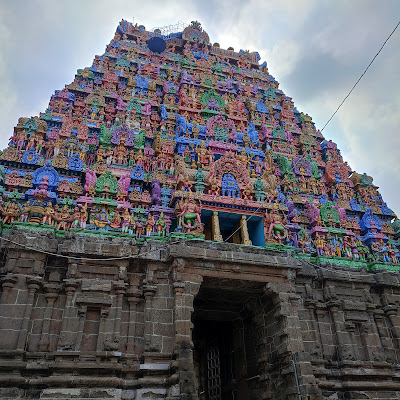Our route to Tiruvannamalai, the first night-halt, was punctuated by stops: Nerur, the samadhi sthala of the great saint Sadasiva Brahmendra; and Salem, where lies the jeeva samadhi of Mayamma, the wonderful avadhuta of Kanyakumari. Both places were magnificent.
Sadasiva Brahmendra finds a place among the six panels leading up to the Dhyanalinga at Isha. We have often heard and read stories of his life, his complete dis-identification with his body, we have heard his songs, typical in their laconic phrasing. His resting place I found restful, more silent than energetic.
Mayamma’s samadhi – a smallish shrine off the Law College Road in Salem – was a place of loving sweetness with an undercurrent of buzz. Fittingly there were dogs here, Mayamma’s most beloved constant companions.
***
One motif running through the entire trip was the rivers, in particular Cauvery whom we encountered time and again, crossing her course several times. Again, a special interest for us. Cauvery Calling, the massive on-ground movement to revive the river is supporting farmers to make a partial shift to agro-forestry. The mission is to plant 242 crore trees in the river basin, revitalizing the soil, and in turn, the river, which has been seeing dangerously depleted levels. We saw first-hand the truly heartbreaking state of the river and the smaller rivers that drain into it.
Near Karur, we went to the fascinating Agatheeswarar Temple on the banks of River Amaravathi, near the confluence of the rivers Kaveri, Amaravathi and the now-dead Thirumanimuthaar. The location was magnificent, the sunlight was brassy gold, birds chirped and flitted, not with the frenzy of dawn but with all the languor of the midday warmth. We’d gone prepared to take a dip in the water but the riverbed was dry, the water just a silvery trickle in the distance. It wasn’t even summer yet. We could see for ourselves what Sadhguru means when he says our rivers are dying. This is not how it’s supposed to be. A river is a huge presence, a life of its own… we have let things go too far.
 |
The temple – built by Rajendra Chola I – is in a state of disrepair. The inner shrine (the linga is said to have consecrated by Agastya himself) was barred. We couldn’t go in but we met some officials there, I think they were from the Department of Archeology; restoration, I learned, is on the cards. In the yard, we found a Shivalinga, a samadhi and a pair of hobnailed padukas*, belonging to a yogi who had lived here, and also left at this spot. How wonderful if the temple and the river are restored together! Can you imagine the powerful serenity that could once again emanate from such a combination?















